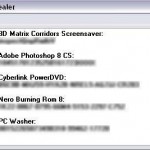 Overclocking is the process of forcing a computer component to run at a higher clock rate than it was designed for or was designated by the manufacturer.Overclocking is usually practiced by PC enthusiasts in order to increase the performance of their computers. Some hardware enthusiasts purchase low-end computer components which they then overclock to higher speeds, while others overclock high-end components to attain levels of performance beyond original specifications.
Overclocking is the process of forcing a computer component to run at a higher clock rate than it was designed for or was designated by the manufacturer.Overclocking is usually practiced by PC enthusiasts in order to increase the performance of their computers. Some hardware enthusiasts purchase low-end computer components which they then overclock to higher speeds, while others overclock high-end components to attain levels of performance beyond original specifications.
Users who overclock their components mainly focus their efforts on processors, video cards, motherboard chipsets, and Random Access Memory (RAM).
Considerations
There are several considerations when overclocking. Overclocking boosts the performance of a computer system by increasing clock frequencies, which requires certain precautions. The first consideration is to ensure that it is supplied with adequate power to operate at the new speed. However, supplying the power with improper settings or applying excessive voltage can permanently damage a component. Since tight tolerances are required for overclocking, only more expensive motherboards-with advanced settings that computer enthusiasts are likely to use-have built-in overclocking capabilities. Motherboards with fewer settings, such as those found in OEM systems, lack such features in order to eliminate the possibility of misconfiguration by an inept user and cut down on the support costs and warranty claims to the manufacturer.
Cooling
All electronic circuits discharge heat generated by the movement of electrons. As clock frequencies in digital circuits increase, the temperature goes up. Due to increased heat produced by overclocked components, an effective cooling system is necessary to avoid damaging the hardware. In addition, digital circuits slow down at high temperatures due to changes in MOSFET device characteristics. Wire resistance also increases slightly at higher temperatures, contributing to decreased circuit performance.
Because most stock cooling systems are designed for the amount of heat produced during non-overclocked use, overclockers typically turn to more effective cooling solutions, such as powerful fans or heavy duty heatsinks. Size, shape, and material all influence the ability of a heatsink to dissipate heat. Efficient heatsinks are often made entirely of thermally conductive copper, but these are often expensive.[1] Aluminum is more widely used material for heatsinks. Cast iron is the least expensive, but it has poor thermal conductivity. Many good-quality heatsink coolers combine two or more materials to maximize thermal conductivity while minimizing cost.
Water cooling and passive liquid coolant carrying waste heat to a radiator which is similar to an automobile engine’s cooling system provide more effective cooling than heatsink and fan combinations when properly implemented, because liquid is denser than air and therefore offers greater thermal transference.
Thermoelectric cooling devices, also known as Peltier devices, are becoming more and more popular these days with the onset of high TDP processors from both Intel and AMD. TEC devices create temperature differences between two plates by running an electric current through the plates. This method of cooling is extremely effective, but is very inefficient, which leads to a lot of excess heat. Because of this, it is necessary to supplement TEC devices with a beefy convection-based heatsink or a water cooling system. Companies like Vigor Gaming offer all-in-one units that combine the advantages of TEC cooling with easy installation. One major drawback of TEC is that they have a large power overhead, sometimes drawing more than 60 W
[Learn more from the free Encyclopedia Wikipedia]






